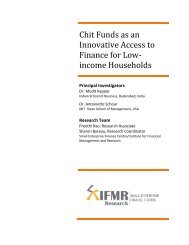Government of India Volume I: Analysis and Recommendations
Government of India Volume I: Analysis and Recommendations
Government of India Volume I: Analysis and Recommendations
Create successful ePaper yourself
Turn your PDF publications into a flip-book with our unique Google optimized e-Paper software.
ANNEXES<br />
issue by providing a list <strong>of</strong> documents to be filed with a Section 14 petition under<br />
SARFAESI. In our view, the proposal in the Debt Laws Amendment Bill (2011) would<br />
be sufficient for addressing this issue. This WG recommends the same list <strong>of</strong> documents<br />
to be filed with a Section 14 petition.<br />
39. A petition for enforcing security interest under Section 14 SARFAESI can only be filed<br />
with a District Magistrate or a Chief Metropolitan Magistrate. In present day administrative<br />
services, the Deputy Commissioner <strong>of</strong> a particular district also acts as a<br />
District Magistrate. A Deputy Commissioner is an administrative <strong>of</strong>ficer principally<br />
responsible for overseeing revenue collection, such as collection <strong>of</strong> l<strong>and</strong> revenue<br />
<strong>and</strong> other public dues. A Chief Metropolitan Magistrate on the other h<strong>and</strong>, does not<br />
exercise executive <strong>and</strong> judicial function but is the administrative head <strong>of</strong> metropolitan<br />
courts in <strong>India</strong>. Since both District Magistrates <strong>and</strong> Chief Metropolitan Magistrates<br />
are involved more in administrative functions than actual day to day judicial<br />
functions, there is considerable delay in addressing petitions under Section 14 <strong>of</strong><br />
SARFAESI. The Debt Laws Amendment Bill (2011) addresses this issue by allowing<br />
the District Magistrate or the Chief Metropolitan Magistrate to authorise any <strong>of</strong>ficer<br />
subordinate to him to take actions for enforcing the security interest. On this issue,<br />
it is the view <strong>of</strong> this WG that the proposals in the Debt Laws Amendment Bill (2011) is<br />
sufficient to address the problem. If the District Magistrate or the Chief Metropolitan<br />
Magistrate is allowed to authorise any <strong>of</strong>ficer subordinate to him to take actions<br />
for enforcing the security interest it would help in reducing delays.<br />
40. In <strong>India</strong> our laws give preference to crown debt in the form <strong>of</strong> taxes <strong>and</strong> statutory<br />
dues over the claims <strong>of</strong> secured creditors during insolvency <strong>and</strong> bankruptcy proceedings.<br />
Though reforms in certain tax laws now provide priority <strong>of</strong> secured creditors.<br />
Tax dues under Customs Act, 1962, Central Excise Act, 1944, <strong>and</strong> service tax<br />
under the Finance Act, 1994 are subject to the claims <strong>of</strong> secured lenders under RD-<br />
DBFI <strong>and</strong> SARFAESI. While these reforms have only partly addressed the issue, the<br />
general principle <strong>of</strong> priority <strong>of</strong> secured lenders over crown debts <strong>and</strong> debts under<br />
other welfare legislations such as labour laws is not specifically provided for in our<br />
laws. This WG endorses the recommendations <strong>of</strong> the Raghuram Rajan Committee<br />
Report (2009) on rationalising insolvency <strong>and</strong> bankruptcy proceedings:<br />
(a) While it is important to protect employee claims such as overdue wages, there<br />
must be a limit, say six months, to which such pay is protected. After the expiry<br />
<strong>of</strong> this period employees must also join the ranks <strong>of</strong> unsecured creditors.<br />
(b) The government, which has substantial powers to recover arrears to it prior to<br />
bankruptcy, should not st<strong>and</strong> ahead <strong>of</strong> secured creditors.<br />
(c) Statutory priorities <strong>of</strong> a firm should be well disclosed so that creditors can act<br />
well in time, before they get crowded out by other claims.<br />
41. The purpose <strong>of</strong> setting up DRTs was to ensure speedy recovery <strong>of</strong> debts by setting<br />
up a special tribunal system which follows a summary procedure as opposed to a<br />
detailed procedure followed by the civil courts. DRTs in <strong>India</strong> are now plagued with<br />
the same problems that afflict civil courts: Huge backlog <strong>of</strong> cases <strong>and</strong> insufficient<br />
infrastructure. An efficient tribunal system has sufficient resources at its disposal<br />
<strong>and</strong> has well trained <strong>and</strong> competent staff. If the objective <strong>and</strong> purpose <strong>of</strong> setting<br />
up DRTs are to be given effect to, one cannot ignore the infrastructure issues that<br />
afflict the DRTs.<br />
To address the infrastructure issues that afflict DRTs in <strong>India</strong>, there is a need to rethink<br />
<strong>and</strong> overhaul the legal framework under RDDBFI:<br />
(a) Objective <strong>of</strong> DRT: Amend RDDBFI to clearly state the objective <strong>of</strong> RDDBFI, as<br />
a special tribunal for providing a mechanism for recovery <strong>of</strong> debt that is fair,<br />
just, economical <strong>and</strong> quick.<br />
188 FINANCIAL SECTOR LEGISLATIVE REFORMS COMMISSION



